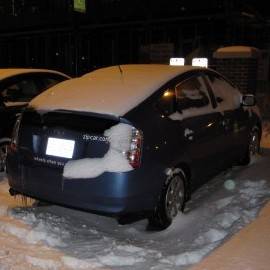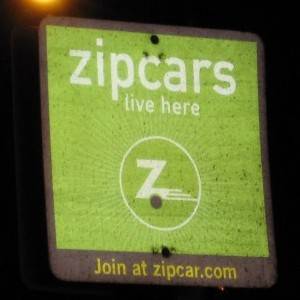 On January 14, Zipcar was introduced to Champaign-Urbana at a press conference at Illinois Terminal. In the two weeks since, Zipcar is off to a bit of a sluggish start, but the local folks responsible for making Zipcar work are optimistic that things will pick up soon, and they have plans in place to continue to get the word out..
On January 14, Zipcar was introduced to Champaign-Urbana at a press conference at Illinois Terminal. In the two weeks since, Zipcar is off to a bit of a sluggish start, but the local folks responsible for making Zipcar work are optimistic that things will pick up soon, and they have plans in place to continue to get the word out..
“As of last Friday, the 23rd, we had 36 members who had used the cars for 26 hours,” said Jan Kijowski, CUMTD marketing director, “and we want to see those numbers skyrocket.”
It’s been a slow start on the usage, but Kijowski is delighted with the number of members, “I think it’s a great start considering that the students had been back only a short time at that point, and the system had been only made public for about ten days,” she said.
 Morgan Johnston, Transportation Demand Management Coordinator for the U of I, is ready to hit students with a media blitz. “We are about to put up posters, create an email message to campus, and schedule sign-up events at various locations on campus,” she said.
Morgan Johnston, Transportation Demand Management Coordinator for the U of I, is ready to hit students with a media blitz. “We are about to put up posters, create an email message to campus, and schedule sign-up events at various locations on campus,” she said.
Kijowski is also preparing to make Zipcar more of a household name around town. “We have the information on the MTD website, and we’re going to advertise aboard all buses and in bus shelters.” Some promotional materials from Zipcar were erroneous, creating a delay in releasing them while the problems were corrected.
Zipcar is a car sharing service based out of Cambridge, Mass. Zipcar allows members to reserve cars online for a minimum of one hour, or a maximum of four days. For non-students (find out more here), membership incurs a $25 signup fee, a $50 annual fee (which as an initial incentive can be applied toward usage charges during the first month of membership) and from there, you pay as you go. The rates are $8 per hour or $66 per day, which includes gas and insurance. The startup costs for students are lower (find out more here), but the usage rates are the same.
Response from the community has been universally positive thus far, Johnston and Kijowski agreed. “When they understand how easy it is, and that everything is included, they usually respond enthusiastically,” Johnston said. “I have not had any conversations with students who are not interested in applying.”
However, Johnston has encountered some misconceptions. “I showed the Zipcar I had rented to a few people at my workplace,” she related, “and three of them said ‘Oh, they’re real cars!’ Apparently, the name Zipcar had led folks to believe these cars are different somehow. But that is not the case, these are just normal cars with a membership program for using them.”
One of the main reasons for locating Zipcars in downtown Champaign was the fact that municipal and other downtown employees could check out the cars for business use. Kijowski says that sort of usage will come, but that business memberships are slow at the beginning as companies establish their internal policies for Zipcar usage.
The only Toyota Prius of the six-car fleet is located in the lot at Neil and Washington, and it has been used most frequently thus far. Kijowski said, “Having a hybrid that you can use is fun for people.”
Now is the best time to give Zipcar a try, because as membership increases, more people will be making reservations. “I would certainly encourage people to not wait until the last minute to reserve a car,” Kijowski stated. “I’m afraid that people will get complacent with them being available on a whim.” If you have a trip planned for later in the year, that’s no problem, because you can reserve a car up to a year in advance. Also, as long as you’re 21 or older, you can use your Zipcar membership to reserve vehicles in any city where there is a program, which includes most major US cities, as well as Toronto, Vancouver and London. Members 18 to 20 years old can only reserve vehicles in C-U.
The revenue guarantees present in the agreement between Zipcar and the Cities of Champaign and Urbana, CUMTD and the U of I are based on car usage of approximately 40 hours per week per vehicle. In order to meet these guarantees, approximately 50 members per vehicle would be needed (based on historical data), or 300 members overall for the current vehicle fleet size. There is still plenty of time to build that kind of membership base, as we are quite early in the game. Zipcar’s public relations representatives did not respond to a request to compare the C-U membership at this point to their expectations.
Have you tried Zipcar yourself? Let us know about the experience, good or bad, in the comments.








